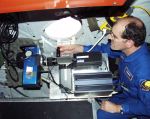
 Peter Jenniskens,
Peter Jenniskens,
SETI Institute
E-mail:
Homepage
Brief Biographical Information:
- Research Scientist with the SETI Institute
- Meteor astronomer, expert on meteor showers
- Author of book "Meteor Showers and their Parent Comets" (Cambridge University Press, 790 pages)
- Principal Investigator of NASA and USAF sponsored Stardust SRC Entry observing campaign and the
earlier Leonid MAC missions.
- Chair of the Task Group on Meteor Shower Nomenclature of IAU Commission 22
Research:
Research Interests, with over 100 publications in scientific journals about:
- The role of meteoric matter in the origin of life
- Meteor outbursts
- Dynamics of meteoroid streams
- Chemical composition of meteoroids
- Physics of meteor flight in the atmosphere
- Meteor persistent trains
- Observations of Diffuse Insterstellar Bands in interstellar extinction
- Laboratory studies of astrophysical ices

Figure 1: Dr. Jenniskens with his slit-less meteor spectrograph "BETSY"
onboard the FISTA aircraft during the 1999 Leonid MAC mission.
Research on Leonid MAC:
High resolution optical spectroscopy of meteors and trains,
and studies of meteor stream dynamics.
Dr. Jenniskens coordinates the various experiments on Leonid MAC in order
to achieve highest synergy.
Jenniskens studies the fate of organic matter in meteoric ablation, with support of
NASA's Exobiology program. He contributes optical spectrometers to the mission,
in order to measure the presence of organic matter in meteors and
the physical conditions that determine if the organic matter can survive
the ablation process. This work
has lead to a new
meteor model that shows potential gentle pathways for organic matter survival
and just the right conditions for interesting atmospheric chemistry.
He also contributes to the mission a large number of intensified video cameras
to document the shower activity. Those records are used:
- to reconstruct the meteor trajectories when
interesting phenomena are observed.
- to determine in real-time the flux of the shower for satellite impact hazard
awareness.
- to measure precisely the meteor flux for accurate determinations of
shower
width and peak intensity, with rates being 4-5 times higher from aircraft
than from the ground.
 Figure 2: AIMIT and miniature Echelle spectrograph on "FISTA" during Genesis SRC Entry campaign
Figure 2: AIMIT and miniature Echelle spectrograph on "FISTA" during Genesis SRC Entry campaign
Research on Hyperseed MAC:
Probe the physical conditions in the path of a meter-sized object by measuring air plasma emissions in the SRC reentry. Jenniskens will use AIM-IT technology to catch the light of the Sample Return Capsule and aim it at the slit of an Echelle spectrograph. If successful, this will provide high resolution spectroscopy over a wide wavelength range from the near-UV to the near-IR.











 Peter Jenniskens,
Peter Jenniskens,